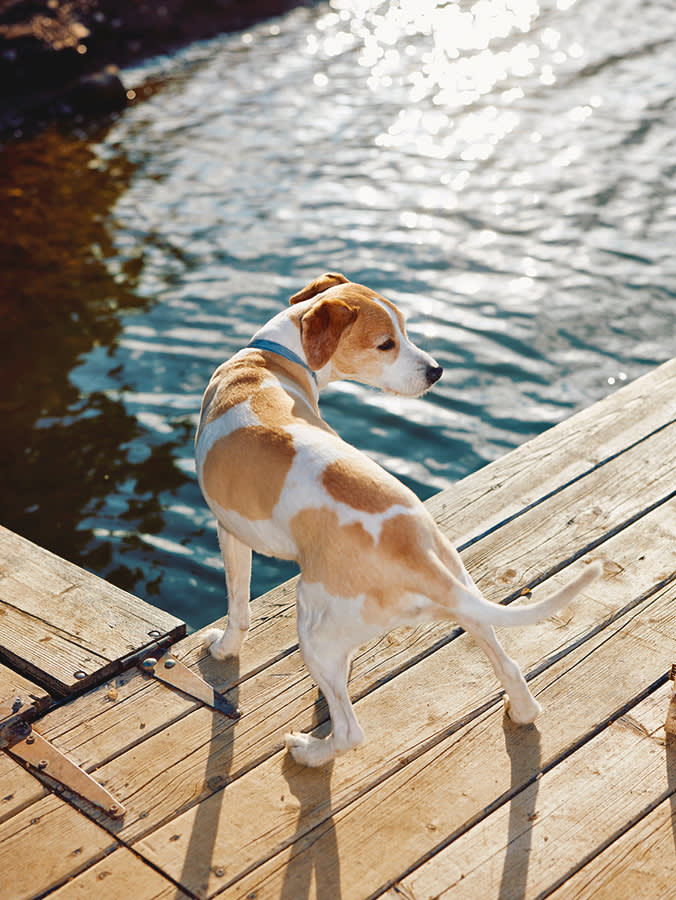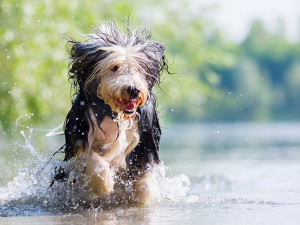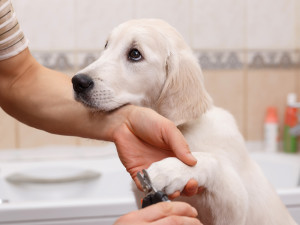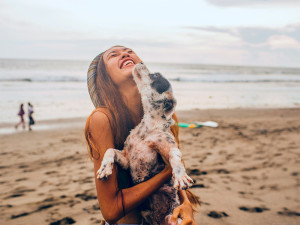Why Doesn’t My Dog Like Water?
All dogs love cooling off by splashing about and swimming in water, right? So why does yours... not?
We’ve all seen those dogs who dive headfirst into the water, happily splashing around as if they were born to swim. But what about those dogs who avoid the water like it’s the plague? Should we nudge them into the sea or plop them into the bath?
If your dog prefers to stay on dry land even on the hottest days, don’t worry, and definitely don’t force them in. Many dogs genetically or historically don’t like swimming or getting wet and that’s okay.
However, understanding why some dogs dislike water can help you better address their needs and keep them comfortable, especially at bath time.
So, to help you out, we asked veterinarian Dr Joey Corrickopens in new tab for expert advice on dogs in water.
Do some dogs hate water?
“Absolutely,” says Dr Corrick, “like humans, dogs have individual preferences, and water isn’t always one of them. You might have noticed at the beach or a lake that while some dogs are eager to chase a ball into the sea, others won’t even dip a paw in. While there are several factors that contribute to a dog’s love or dislike of water, much of it comes down to genetics and breed.”
Some dog breeds love water
Certain dog breeds have a natural affinity for water, often due to their breeding history. These dogs were historically bred for tasks that involved swimming, and as a result, they tend to be more comfortable and even enjoy being in the water.
Here are some water (fur) babies that have a natural love for swimming:
American Water Spaniel
As their name suggests, American Water Spaniels are natural swimmers. Originally bred to retrieve game from water, these dogs have a dense, water-resistant coat and are known for their enthusiasm in the water.
Labrador Retriever
Labradors are perhaps the most famous water-loving dogs. Bred for retrieving game from water, they have webbed paws and a thick, water-resistant coat that helps them stay warm and buoyant in the water.
Portuguese Water Dog
Bred for herding fish into nets in southern Portugal, Portuguese Water Dogs are strong swimmers with swift, balanced strokes. Their tail acts as a rudder, and their light, single-layer coat aids in buoyancy, making them excellent swimmers.
Cocker Spaniel
“Don’t let their flowing fur and smaller stature fool you – Cocker Spaniels are excellent swimmers,” says Dr Corrick. “Originally bred as versatile hunting dogs, they have webbed toes and strong endurance levels. Their water-repellent coat makes them well-suited for swimming.”
Newfoundland
These gentle giants were bred as working dogs for fishermen, often tasked with hauling nets or rescuing people from the water. “Their large size and strength, webbed feet, and thick double coat make them natural swimmers,” adds Dr Corrick.
Some breeds don't like the water
On the flip side, some breeds just aren’t built for water. Whether due to their physical structure, coat type or temperament, these dogs are more likely to stay on dry land.
Pug
Pugs have a short snout and a compact, muscular body, which can make swimming challenging. They’re also more prone to overheating, so they might prefer to avoid exertion in water.
French Bulldog
Like Pugs, French Bulldogs have a brachycephalic (short-nosed) structure, which can make breathing more difficult in the water. Their stocky build also doesn’t lend itself to strong swimming.
Dachshund
With their long bodies and short legs, Dachshunds aren’t built for swimming. Their shape makes it difficult for them to stay buoyant, and they might tire easily in the water.
Greyhound
Greyhounds are built for speed on land, not for swimming. Their lean bodies and low body fat mean they’re not naturally buoyant, and they may feel more uncomfortable in water than other breeds.
Shih Tzu
Shih Tzus have a long, flowing coat that can become heavy and uncomfortable when wet. Their small size and brachycephalic structure can also make swimming difficult.
Why does my dog not like getting into the water?
Understanding your dog’s aversion to water can help you address their fears. Perhaps you have a breed that naturally dislikes the water, but there are other factors too. Dr Corrick shares some of these reasons:
Past experiences: if your dog has had a negative experience with water, such as being thrown into a pool or struggling to stay afloat, they may develop a fear of it.
The texture and feel of water: some dogs simply don’t like the sensation of water on their fur or skin, particularly if it’s cold.
Enclosed spaces: bathing can be especially stressful for dogs who don’t like confined spaces. The noise of the shower, being lifted into the bath or feeling trapped can all contribute to their fear.
Fear of the unknown: for dogs who haven’t been exposed to water regularly, the experience can be unfamiliar and intimidating.
Sounds of splashing: the noise of splashing water can startle some dogs, making them wary of getting too close.
Water getting into ears or eyes: in particular floppy eared dogs sometimes struggle to fully remove water from their ears which may cause issues.
How can I make my dog like water?
If your dog is hesitant around water, there are ways to help them become more comfortable but remember, you should never force them to do anything they're uncomfortable with:
Start small: begin by introducing your dog to water in a controlled environment, such as a shallow paddling pool. Let them explore at their own pace.
Positive reinforcement: reward your dog with treats and praise whenever they show interest in water. This helps build a positive association.
Bath time: make bath time as stress-free as possible. Use a gentle spray, and avoid getting water in their ears or eyes. Consider using a non-slip mat to help them feel secure.
Introduce swimming gradually: walk with your dog along the shore to get their feet wet before gradually moving into deeper water. Always stay in shallow water until they’re comfortable.
Should you push them to experience water?
“It’s important not to force your dog into water if they’re uncomfortable,” says Dr Corrick. “Forcing them can reinforce their fear and make them even more reluctant to go near water in the future. Instead, encourage them gently and always allow them to retreat if they feel overwhelmed.”
How can you teach a dog who avoids water to be safe and comfortable around it?
“Safety should always come first. Even if your dog doesn’t like water, it’s essential to ensure they know how to handle being around it,” says Dr Corrick. Here’s how:
Use a life vest: for dogs that are particularly fearful or not strong swimmers, a life vest can provide extra buoyancy and help them feel more secure.
Train in shallow water: start in shallow water where your dog can stand and feel in control. Gradually work your way to deeper water as they become more comfortable.
Stay calm: your dog can pick up on your emotions, so it’s important to stay calm and reassuring. If you’re anxious, your dog might be too.
Some dogs are natural swimmers, while others prefer to stay on dry land. Whether due to breed, past experiences, or simply personal preference, not all dogs enjoy water. Understanding your dog’s unique relationship with water can help you create positive experiences and ensure their safety, whether they’re wading in the shallows or happily lounging on the shore.







